What is a Dental Implant?
Types of Implants and Restorations
There are now more than 40 different types of what can now be termed traditional or standard implants available today. There are also two others, mini and micro-mini implants. Mini implants are like traditional implants but usually smaller in diameter where as micro-mini implants are a variation of the now more traditional implant design, but smaller, narrower and more screw like in appearance, they are more temporary in nature and designed to be easily removed.
Types of Implant Restorations:
- Single tooth replacements: use one implant and as the name suggests support a single crown.
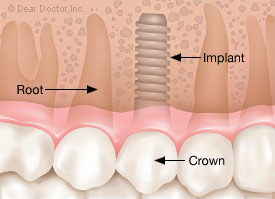
- Multiple tooth replacements: multiple missing teeth can be replaced with multiple implants supporting fixed bridgework as small as a 3-unit bridge supported by two implants, or with multiple implants supporting a greater number of teeth. Usually a minimum number of 4-8 implants are needed to replace a full arch (jaw) of teeth, 10 or more crowns by fixed bridgework .
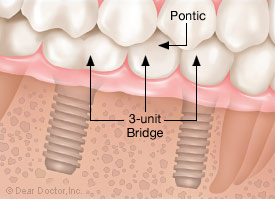
- Combinations of fixed and removable bridgework: generally where implants are used to support a section of fixed bridgework, to which is attached a removable section.
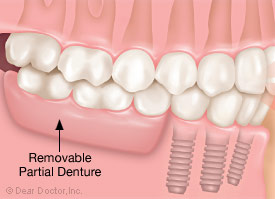
- Over-dentures: where two or more implants, either standard or mini-implants, are placed to provide stabilization of the denture and preserve the underlying bone. Whereas most traditional full dentures press directly on the gum and bone causing bone loss by resorption, implant supported over-dentures protect the bone. Over-dentures are now considered the standard of care by the American Dental Association for the patients who have lost all of their teeth in one or both jaws.
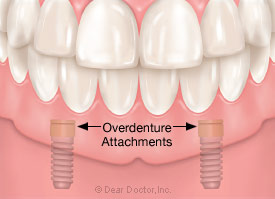
- Anchorage for tooth movement (orthodontics): Implants, either standard, mini, or micro-mini implants, are now being used to provide very stable and non-movable anchor units to allow quicker and easier tooth movement.

- Temporary bridgework: utilize micro-mini implants which are later removed when the permanent implants are healed and teeth permanently replaced. They ensure that at no time will a person be without teeth and can therefore be socially comfortable and functional.
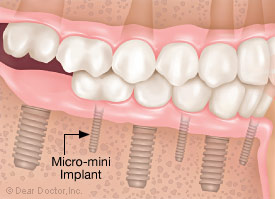
Surgical Placement:
Dental implant surgery is a relatively comfortable procedure usually carried out under local anesthesia (numbing the area where the implant is to be placed), sometimes with the assistance of oral medication or intravenous conscious sedation for anxious patients. Some minor vibration is generally experienced during the implant (bone) site preparation, but it is quite tolerable. Since there are no open wounds following the surgery and it is minimally invasive, there is little post-operative discomfort, perhaps a day or two. The implant(s) need to be left for a period of 2-6 months to fuse or integrate with the bone in most circumstances. The healing time depends upon the bone density of the site, the more dense the bone, the quicker the integration. When the implant has integrated with the bone a crown can be made and the implant “loaded” that is, subjected to biting forces. Following successful integration your dentist will make a crown which fits on the implant and will be exactly like a normal tooth both in form and function.

Post a comment